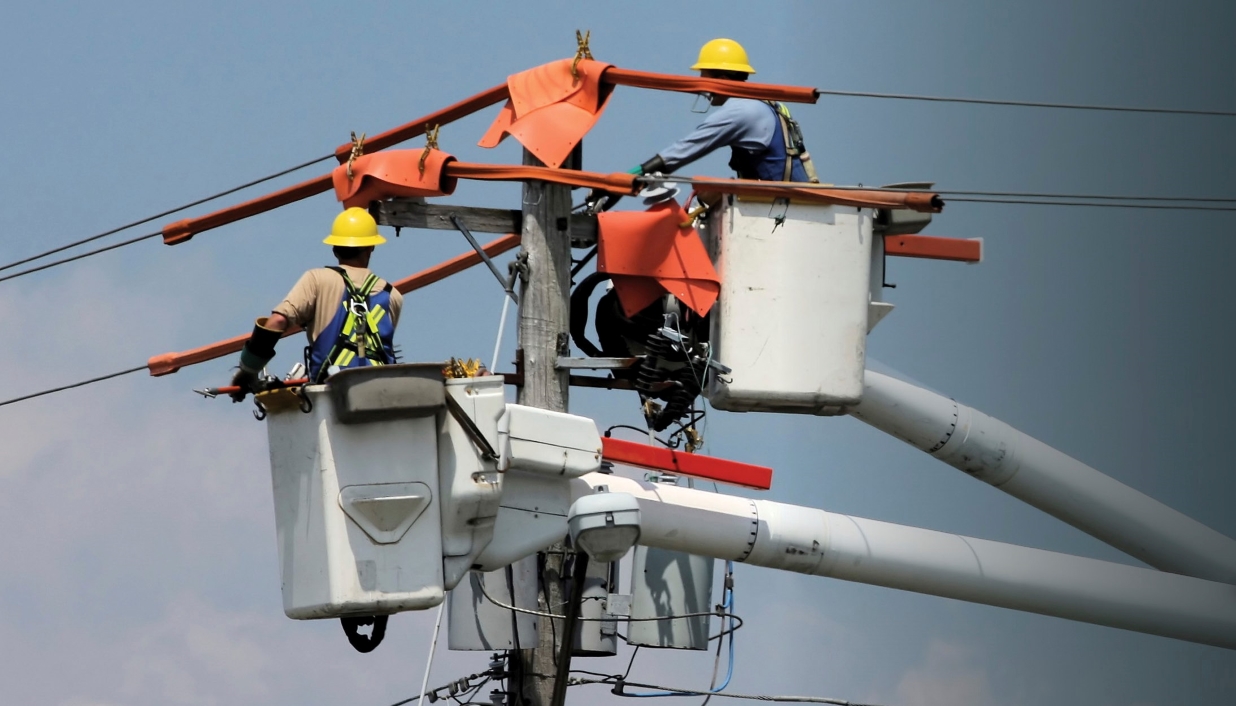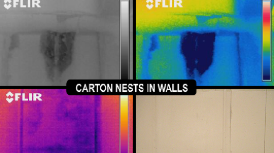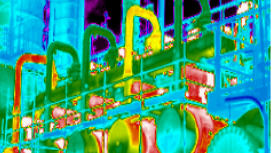Predictive and Preventive Maintenance in Power Utilities

InfraMation 2018 Application Paper Submission
Darryl Mendivil
Mid State Instruments LLC
Jim Neilson
PG&E
ABSTRACT
This paper discusses the importance of predictive and preventive maintenance in the power utilities industry. Predictive maintenance is the monitoring of equipment for conditions indicating impending system failure. The objective is to detect system problems and determine whether corrective action needs to be taken before the system fails. This is especially true in the power utilities industry where systems failures can be unacceptably expensive and potentially disastrous. This paper will further discuss the various utility groups involved, their roles, and the procedural requirements expected to perform predictive and preventive maintenance.
INTRODUCTION
Infrared thermography has developed into one of the most significant sensing technologies to be applied for detection and monitoring of power utility equipment. Infrared cameras and thermal imagers capture two-dimensional representations of the apparent surface temperature of electrical components. Apparent temperature, in most cases, is significantly different from actual temperature; the difference is generally caused by the emissivity of a material’s surface. An understanding of emissivity and thermal characteristics of materials is essential in reading and understanding the apparent temperatures displayed by infrared images.
Since electrical modules in power systems almost always overheat before they fail, infrared cameras and thermal imagers are essential tools in identifying problem areas. Vital non-contact inspections and assessments are made possible through these specialized tools.
Thermal imagers can be used for most types of electrical inspections and detect electrical issues including:
•excessively hot or loose connections
• load imbalances
• corrosions
• overloading wiring
• overloaded circuits
• overloaded transformers
• overloaded motors
• arcing
• excessive harmonics
All areas of the power utility system, such as generation, transmission, and distribution use thermography in a wide variety of situations.
PREDICTIVE/PREVENTIVE MAINTENANCE
Typical maintenance programs are directed by equipment failures or by a consistent but infrequent 3, 6, or 12 monthly routine maintenance plans. Maintenance tasks that are undertaken during these routine checks assume that the equipment component will degrade within a time period that is common for its type. The degraded components will be removed, replaced, or rebuilt, on or before the expected failure point. There is little attempt made to monitor the equipment performance. However, through thermal imagers and infrared cameras, these practices are becoming more and more obsolete. Inspections and assessments can be done quickly and efficiently with the help of infrared thermal imagers. Predictive and preventive maintenance is determined by the condition of the equipment rather than the average or expected life of the equipment. Principally, this methodology tries to predict the failure before it actually happens by directly monitoring the machine equipment during normal operating conditions. In many cases using thermal imagers can identify issues to be addressed during routine maintenance, minimize system component deterioration, and avoid emergency restorations. These benefits lead to reduced maintenance costs, minimized impact on production, increased revenue (for both utility and customer), and increased reliability.
GENERAL INFRARED INSPECTION PROCEDURES
The power utility industry established requirements for performing infrared inspections on overhead (OH), and underground (UG) electric distribution facilities. Before starting inspections, all personnel must wear personal protective equipment (PPE) at all times when performing IR inspections. This includes but is not limited to: flame resistant clothing, hard hat, safety glasses, and suitable footwear. Table 4 shows the infrared cameras personnel should employ when performing infrared inspections. All personnel performing infrared inspection must have knowledge of industry specifications and manufacturer recommendations. When performing infrared inspections, all personnel must record all relevant information and report defective or damage components. They must also determine the appropriate maintenance priority based on the temperature values. Table 1 and table 2 shows an example of a maintenance priority table as assessed by utilities companies for overhead and underground distribution facilities.


Based on industry specifications, connectors have lower operating temperatures than their respective conductors. A higher resistance connection is likely any time the temperature of a connector is greater than the temperature of its respective conductor. If this occurs, a failure can be expected but not precisely predicted. Connector degradation occurs faster with an increase load or temperature.
Conductor manufacturers recommend a usual maximum operating temperature for tensioned, bare conductor of 85°C (185°F). They also recommend that the usual maximum operating temperature for insulated conductor be limited to the following temperatures:
•75°C (167°F) for high molecular weight polyethylene (HMWPE) material
• 90°C (194°F) for cross-linked polyethylene (XLPE) material
• 105°C (221°F) for ethylene propylene rubber (EPR) material
Establishing the proper IR imaging-system setup parameters for emissivity and background temperature is important in obtaining accurate measurements. As mentioned above, an understanding of emissivity and thermal characteristics of materials is essential in reading and understanding the apparent temperatures displayed by infrared images. Setting the emissivity value at 1.0 eliminates the need to set the background temperature. In this case the target is considered a blackbody, an object that absorbs all incoming light and non-transmissible. Temperature measurements with highly emissive targets is well within reason for predictive maintenance application because the actual reflected energy is so small in respect to the emitted energy. As the emissivity value of the target decreases, the influence of the background radiation increases and, as a consequence, the potential for errors based on background temperature settings also increases.
Utilities personnel must follow infrared scanning techniques to receive accurate readings. Table 3 below shows the infrared inspection measurement points according to utility company standards. The table consists of eight separate figures that display the temperature measurement points in various conductor assemblies. Personnel must observe excessive temperature readings for figures depicted. In the viewer of IR scanning device, center the targeted component (marked 1 in Table 3 below, figures 1 through 8) and observe the measured temperatures.


The advantages of using thermal cameras are numerous, including but not limited to being:
• non-contact, which helps ensure safe inspections
• fast and able to cover lots of space
• non-intrusive and can be used without interrupting production
• light and portable

Pictured above in figures 1 and 2 is a FLIR T640 infrared camera mounted and placed on the truck bed. This application of the FLIR T640 is designed for predictive and preventive maintenance of overhead lines in a quick and timely manner. The infrared camera is controlled by a joystick inside the cab. It records and documents information with the FLIR Research IR software. When active, the vehicle can move up to 50 mph and the camera will record the data.

The software used in this application has an alarm function that detects abnormal temperatures. The personnel monitoring the infrared camera and overhead lines are notified as soon as the camera detects an anomaly.
This setup has many advantages:
• Fixed unit as well as portable
• Controlled from cab or truck bed
• Fast recording and documentation
• Alarms to notify of problems
OVERHEAD LINES AND OVERHEAD CONDUCTORS
The application setup mentioned in the section above can monitor and detect the following:
•Circuit Reliability Projects
• Special Zones, Fire areas
• Emergency conditions
• Insulation failures
• Connector failures
• RTVI
Below are some images of overhead lines captured by infrared cameras.

Infrared cameras such as the FLIR T640 come with a multitude of helpful accessories. These accessories include a range of interchangeable advance optics, additional batteries and chargers, camera pouches, tripod adapters, and FLIR IR windows tool. These accessories can help utility personnel stay organized and complete their work in accordance to applicable safety codes. Utility personnel may sometimes need to inspect remote or inaccessible areas that may be wired down. They need equipment that allows them to do their jobs without entering or getting close to the restricted area. The 7° lens is an interchangeable lens for FLIR T640 that can help them finish the job. The 7° lens is like a telephoto lens for the infrared imager. It allows a much more accurate reading as well as closer view of the overhead equipment. Using the 7° lens, personnel can inspection locations that would otherwise have been left uninspected due to limited access.
ELECTRICAL VAULT INSPECTIONS (UNDERGROUND ELECTRIC INSPECTIONS)
Many power utility companies incorporate infrared scanning in conjunction with regular scheduled and/or state mandated maintenance inspections of their underground electric distribution facilities. Underground cables and equipment can be installed within subsurface enclosures, vaults and ground level accessible pad mounted applications. IR cameras offer an additional safety measure in these close-quarter environments by allowing utility workers to identify compelling conditions and mitigate these potential arc flash and electrocution hazards before entering the space. Most underground distribution electric components are constructed of multiple materials and layers making it difficult to diagnose problem areas. IR cameras can visually display the particular point of suspicion, aiding in determining the exact failure point and best corrective action. Pictured below is an example of what is inside an electrical vault. The infrared image shows that not only was the hot elbow compromised, but also the entire switch at bushing well insert. The vault was secured and clearance limits established before de-energizing commercial and residential customers to complete repairs.

SUMMARY
Infrared thermography using infrared cameras and thermal imagers capture two-dimensional
representations of the apparent surface temperature of electrical components. It has developed into one
of the most significant sensing technologies to be applied for detection and monitoring of power utility
equipment. Vital non-contact inspections and assessments are made possible through these specialized
tools and can save time, money, and lives.
REFERENCES
Gromicko, Kick and Ward, Ethan; 2016, “IR Cameras: Electrical Inspections”; <https://www.nachi.org/ircamera-electrical-inspection.htm>.
Villareal, Lisseth; 2013, “Infrared Inspection of Electric Distribution Facilities.”
Villareal, Lisseth; 2015, “Revised Corrective Maintenance Priorities Tables when Performing Infrared
Inspections.”
ACKNOWLEDGEMENTS
The author wishes to thank the Infrared Training Center at FLIR Systems and Jim Neilson for providing
the resources to make this work possible. He is also grateful for the support of the utility companies’
maintenance personnel who provided additional data and information for this paper.
ABOUT THE AUTHOR
Darryl Mendivil graduated from University of California, Santa Barbara with a Bachelor’s degree in
Political Science and Economics and a Masters in Business Administration from University of La Verne.
Darryl has worked with prominent companies such as FLIR, Ametek Land, Cisco CEMS, Matheson Gas
Products and more. In 2000, he established Mid State Instruments, a leading distributer of Infrared
Cameras and Gas Detection, and Test and Measurement Products in San Luis Obispo, California. Darryl
has over 28 years of experience in Infrared camera applications and training.


